When Eric Geboers lofted the 1988 500cc MX GP world title trophy, he became the first rider ever to celebrate world championship success in all three classes of top-level motocross
Eric Geboers and his four older brothers proved Belgium has more to offer the motorcycling world than Spa-Franchorchamps, one of the most beautiful road racing circuits circuits in the world or Étienne Lenoir, the bloke who happened to produced the world’s first working internal combustion engine.
Once and for all, Eric Geboers put Belgium on the map as a motorcycle nation of true and hard-core terrain specialists, and it’s a reputation that has held up to this very day.

Eric Geboers wasn’t the only successful off-road racer Belgium has ever known; Rene Baeten, Joël Robert, Roger de Coster, Gaston Rahier and Eric’s brother Sylvain had already shown him what was possible while he was growing up. Eric, however, was a remarkably talented motocrosser, small in statue but with a very powerful physique, an extremely determined rider that excelled on pretty much any track. In fact, the rougher and heavier the surface, the more his deep pool of talent would shine…
This combination of talent, skill and sheer determination earned him five world championships during his 10-year career, two in the 125cc class, one in the 250cc class and two in the 500cc class. It also made him the first person on this earth to become motocross world champion in all three 125cc, 250cc and 500cc solo classes.

Born in 1962 in the Belgian town of Neerpelt, Eric’s father owned a petrol station where he initially sold cars but, as time went on, he also started trading in 50cc mopeds and scooters. He was a talented amateur motocrosser, much to the liking of his oldest son Sylvain who was 16 years older than Eric. As soon as Sylvain mastered riding a motorcycle, he followed in his father’s wheel tracks on Belgium’s demanding motocross and enduro circuits where he immediately showed his vast talent.
In just his first season, Sylvain became Belgium’s National Junior Champion. In fact, on the day Eric was born, Sylvain won a junior support race which was part of the prestigious Belgian Grand Prix motocross event. But Sylvain wasn’t the only brother of young Eric that was active in motocross, Louis, Diseré and Jan were also fanatical riders.

Motocross was expensive, though it got a lot easier for the entire Geboers family when a supporter’s club was erected to help finance it all and to jump-start Sylvain’s career. Sylvain eventually became a works rider for CZ and later Suzuki.
Eric benefited from all of this, of course. From a young age he saw his brother battle it out against the big names of the era and he, too, dreamed of doing the same. It did not take long before he quietly took his father’s trade mopeds for a spin – into the bush… it was immediately obvious that Eric possessed a lot of talent, too.
His brother’s club embraced him as soon as his talent began to blossom. The club, named <i>de Gebroeders Geboers<i> (the Geboers Brothers) remained active supporters of the pair all through their careers. They raised money through subscription fees and by organising tours to the events the brothers participated in. For 30 years from the beginning of the 1960s, the club worked hard to support the Geboers boys and remained a wonderful source of motivation.
Eric was a short guy at 168cm. In fact, it earned him one his most famous nicknames in off-road racing of the era: ‘the Kid.’ This came from Steve Whitlock, the American manager of Honda’s MX GP racing team, who deemed it important for all riders to have a nickname. For a long time, Eric’s nickname was visible on his riding gear.
Eric’s public debut as a Geboers brothers motocrosser was on 15 August, 1978, the day that Sylvain retired from active competition. It was a special day at the challenging Belgian Keiheuvel circuit near the town of Balen, all brothers arrived on the start of Sylvain’s last race and Eric had just had turned 16 so he was eligible to race. His brothers Louis, Sylvain, Jan and Diseré were flabbergasted by his speed straight out of the gate – it was a sign of things to come. Eric’s racing debut came in Belgium’s hard fought 500cc Junior class onboard Maico machinery. He was fast from the start, but due to his small physique he lacked the power and endurance to compete at the highest level. Eric identified this early and trained incredibly hard in order to improve his physique.
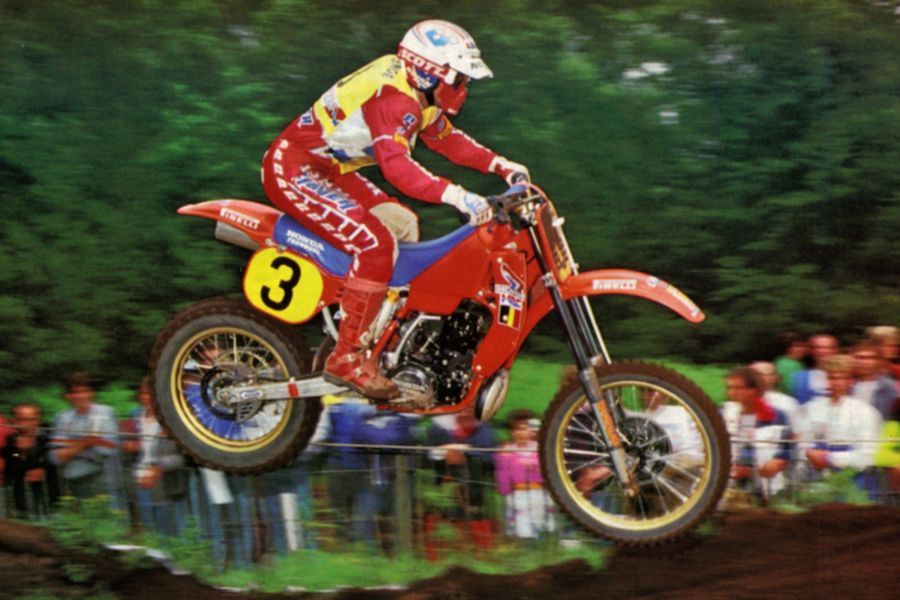
He took a scientific approach to training and was one of the first motorcycle athletes to do so. He followed a medical training program that was designed specifically for him, using lactate tests and continuous heart monitoring. Gone were the days of drinking as little fluid as possible during training “to harden the body” and eating enormous steaks just before a race which was common practice for many racers at the time.
Eric was very conscious of his diet and he worked relentlessly to improve his stamina, participating at triathlons in between seasons to keep in shape. He wasn’t shy of unconventional methods, either. He owned a vest with a liner of lead plates, which he wore during his training exercises. Besides his power training he also jogged and cycled. He worked closely together with specialised sport coaches to reach the highest result. When his career progressed, he trained less and less on the tracks, but instead enhanced his physical exercise routine.
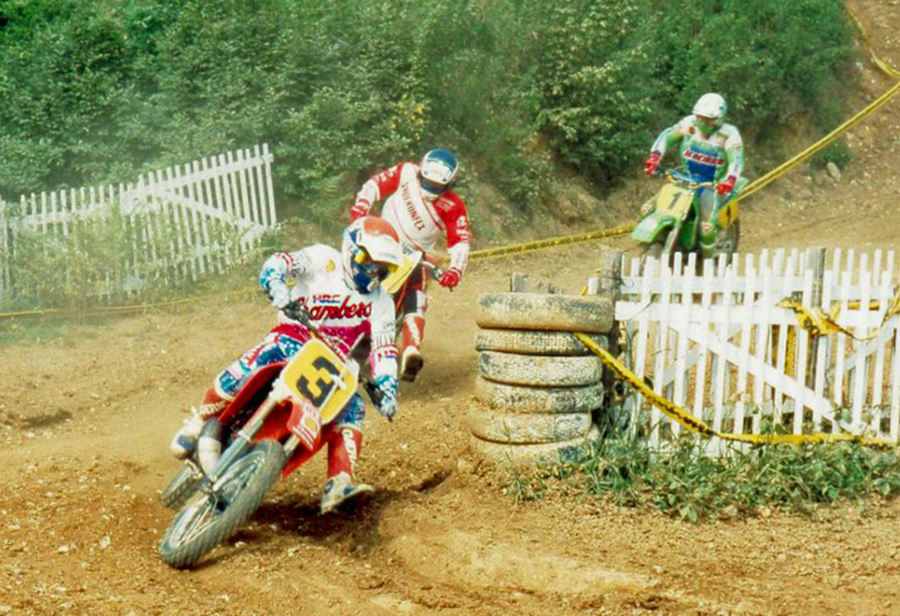
His results on the tracks spoke themselves. He changed the way his rivals viewed professional training in motorsport and he firmly believed a well-trained physique prevents injury. And his relatively short list of personal injuries during his active career of 13 broken bones in his hands, wrist, collarbone and knee proved his point.
It took Eric a year to build up enough stamina to start winning races. In the meantime, he moved over to the 250cc class, hoping to find a more fierce and challenging competition. It worked, in June 1979 Eric won his first race at Belgium’s Ciplet circuit, riding his Maico 250. \A few days later, at Mettet’s circuit, he won again. From then on, he got noticed and his career skyrocketed. In 1980 Eric participated in the 500cc National Championship of Belgium. He wins the races in Westerlo, Koersel and Weelde. At that point he wanted to move up as a professional to the GPs, but at 17-years-old, he was still a year off the minimum age of 18.
Despite that, he eventually did debut as a 17-year-old in the 1980 World Championship motocross series. The FIM had lowered the age limit for the 1980 season to 16 years, but it wasn’t communicated as well as it could have. Eric’s team found only out by coincidence after the first two GPs of the season in the Netherlands and Austria had already been run.
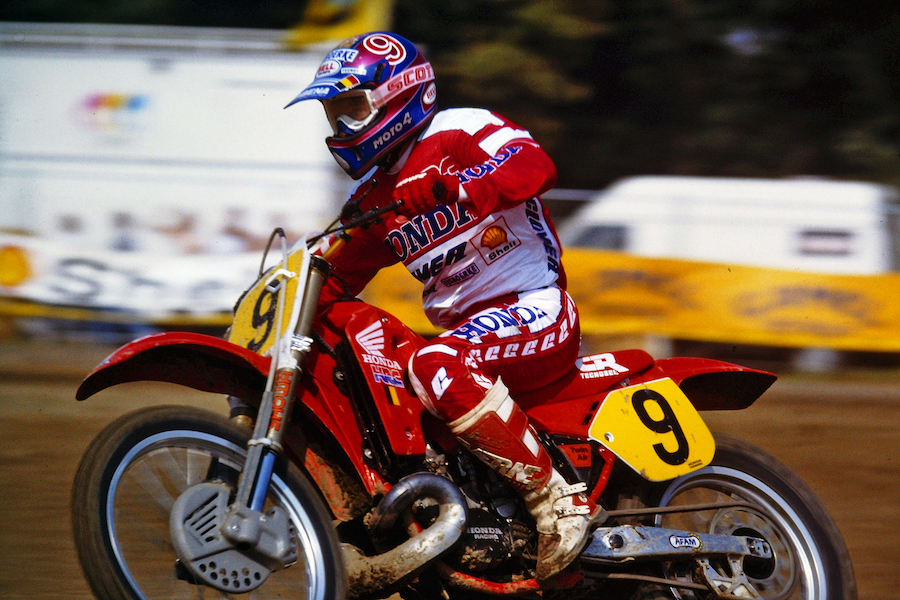
This meant Eric made his official grand prix debut during the Belgian GP at Hechtel in the 125cc class with Suzuki. To everybody’s surprise, he finished 4th, beating many established international top riders in the process. This created quite a stir. Suzuki jumped, team manager Sylvain was asked to sign his brother and Eric received semi-works machines for the remainder of the season. The second GP that Eric participated in was the French GP, held at the circuit of the World War I stricken town of Verdun – which he went and won, before also claiming the victory in the German and Czech Grands Prix, too.
It was a magnificent string of success in the year of his GP debut. At the end of the season Eric also participated in the so called <i>Beker of the Toekomst<i> (Trophy of the Future). This event was organised by six-times world champion Joël Robert and was an unofficial world championship for riders aged under 21. Eric won the 250cc race, in the process beating reigning the 1980 250cc world champion, Georges Jobé. At that point he was considered one of the greatest upcoming talents in motocross.
His professionalism, strong will and determination started to pay off. Sylvain and the Gebroeders Geboers supporter’s club were well pleased with his outstanding achievements. They had delivered a future champion who finished his debut year in the 125cc MX GP world championship in third place, behind his fellow countryman Harry Everts on Suzuki and Michele Rinaldi on TGM. More importantly, Eric realised after the 1980 motocross season that he was capable of more.
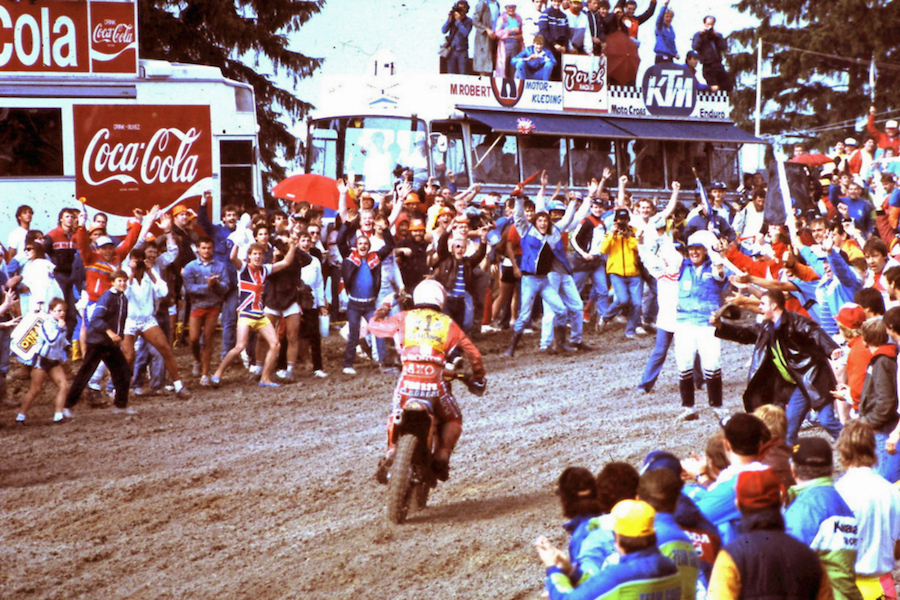
He proved that in 1981. As a full Suzuki works rider, he finished second in the 125cc world championship that year, behind teammate Harry Everts, but ahead of Rinaldi who rode for Gilera that year, winning the French, Czechoslovakian and Spanish GP.
merely a sign of things to come, for the following season he won six Grands Prix on his way to lofting the 125cc world championship title – an excellent achievement considering the level of competition in the class that year. Especially from Gilera works rider Corrado Maddii and Michele Rinaldi, who finished the 1982 championship in second and third place respectively.
In 1983 Eric again won the 125cc MX world championship, winning five of the first six races. It was a magnificent year for Belgium, Georges Jobé won the 250cc world championship, Eddy Lejeune nabbed the second of his World Trial Championships and Belgium also won the Motocross des Nations.
With Suzuki withdrawing from MX GP racing at the end of 1983, Eric could chase his 500cc aspirations and signed with Honda, leap-leapfrogging the 250cc category in the process.
The 1984, 1985 and 1986 500cc seasons were dominated by André Malherbe and Dave Thorpe. A crash in the 1984 British GP broke his knee and meant he missed half of the season. He’d finish fifth in the points chase – the world championship result of his career. Still hampered by his knee injury the following season, he went on to win two GPs and place third overall, the same place he’d rank in ’86, again behind Thorpe and Malherbe.
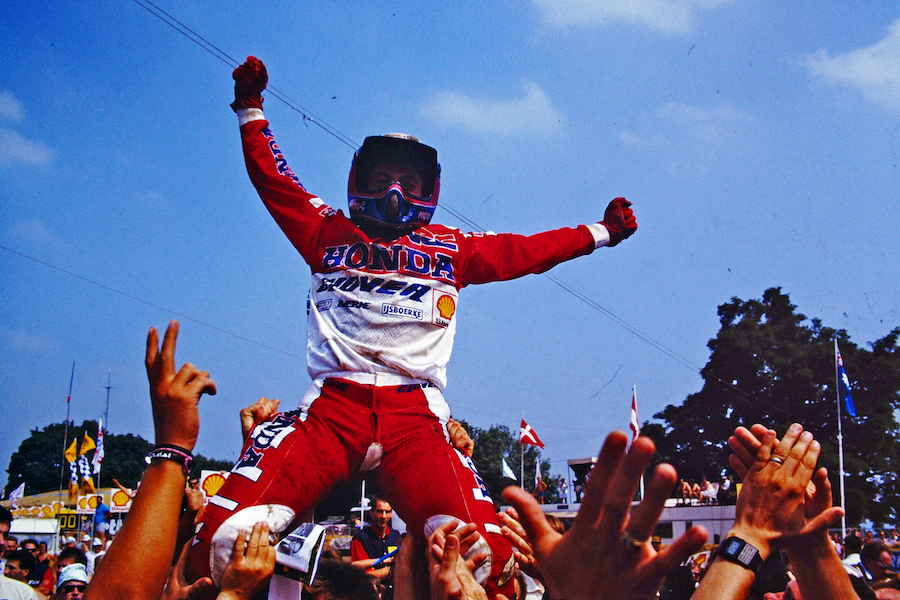
Honda’s MX team manager at the time, Steve Whitlock, convinced Eric that the 1987 250cc world title would be a reasonably easy to gain and, with the promised that Eric could return to the 500cc class if he won it, he gave it a go.
Though it was far from relatively easy. The competition was fierce, but it only made Eric more determined to achieve his goal. With a mindset that there was no reason why he couldn’t win the 250cc world title, he fought himself through a long and hard season. He succeeded and won his third world title, his first and only in the 250cc class.
Whitlock kept his promise and in 1988 Eric was back in the 500cc class and Eric knew if he could win the title, he would become the first ‘Mr 875cc’, the only rider to ever celebrate title success in the 125cc, 250cc and 500cc categories.

What followed was an epic season in which Eric fought out a hard and bitter battle with Kawasaki works riders Kurt Nicoll and Hakan Carlqvist, as well as his teammate Dave Thorpe. Fitter and faster than ever, he won a hard-fought five grands prix that season, the last in front of an adoring home crowd and which cemented his 1988 500cc world title. His name would forever go down in history as the first person to claim world championship success in all three solo motocross classes.
A remarkable achievement in an utmost competitive era. Every class had its challenges and fierce rivals and Eric was the first to successfully navigate his way through, forging his own path of preparation and therefore performance. He had mastered it all and had beaten everything and everybody and he had done it all through gritty determination (and a bucketload of talent).
He awarded Belgium’s Sportsman of the Year, the prestigious national Trophy for Sportmerit, as well as the country’s Oscar for the Sport. Yet another stellar year for the nation, exactly 30 years after Rene Baeten became the first Belgian to win a motocross world championship.

However, in 1989 it would not go so well. Eric finished third in the 500cc world championship, behind his Honda teammates Dave Thorpe and (now KTM Australia’s general manager) Jeff Leisk. Eric had won everything that could be won, he felt his motivation suffered as a result. He decided he’d give it just one more shot and when the 1990 500cc season started, he was in top shape and so was his Honda.
Six grand prix victories that season earned the determined off-road racer his fifth world title ahead of some of the kings of the sport such as Kurt Nicoll (KTM), Dirk Geukens (Honda), Jacky Martens (KTM) and Dave Thorpe (Kawasaki). And the fact that he clinched it on his 28th birthday and in front of him home crowd only added to the feast. Full and content, Eric Geboers announced his retirement from motocross the following day.
He started a helicopter service which he flew human organs for urgent transplants all over Belgium, saving several human lives in the process. He also launched a promotions company that ran GPs across Belgium. He remained active in the MX scene until 2015, working as team manager of Geboers Racing Promotion, which was the outsourced Suzuki MX world championship team owned by his brother Sylvain.
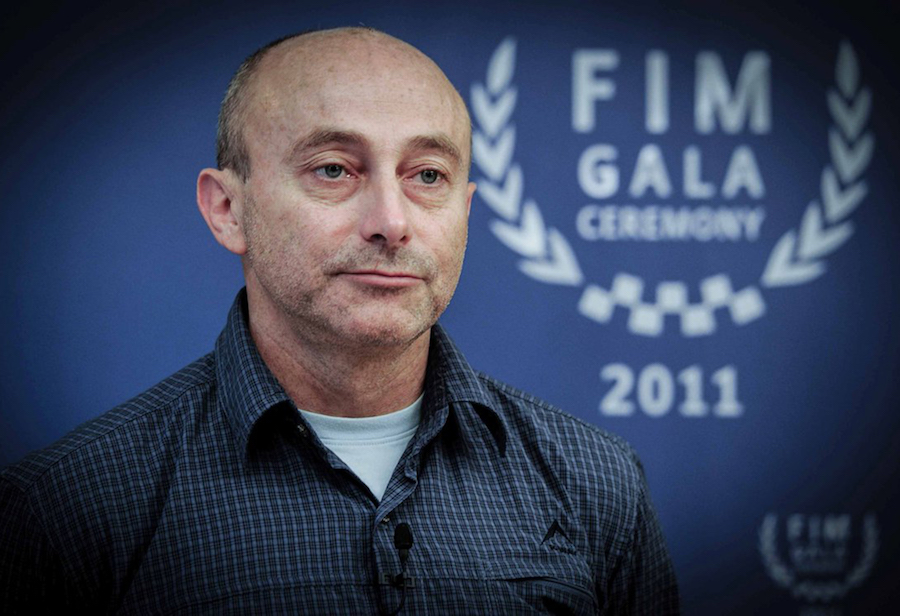
Eric also became active in four-wheel racing. He had participated in the Africa edition of Paris Dakar and in the new millennium and competed in a number of endurance races in the FIA GT championship. In 2001 and 2002 he entered the 24-Hour of Spa-Francorchamps with a Porsche 900 Biturbo.
On 6 May last year, Eric drowned in a lake near his hometown trying to save his dog after it fell from a boat.
The motorcycle world was forced to say goodbye to the 39-time GP winner and the first man to win five world titles in all three classes of top-level motocross. Stepping down as the reigning champion of a category which no longer exists, he will not only always be the first, but also always the only.
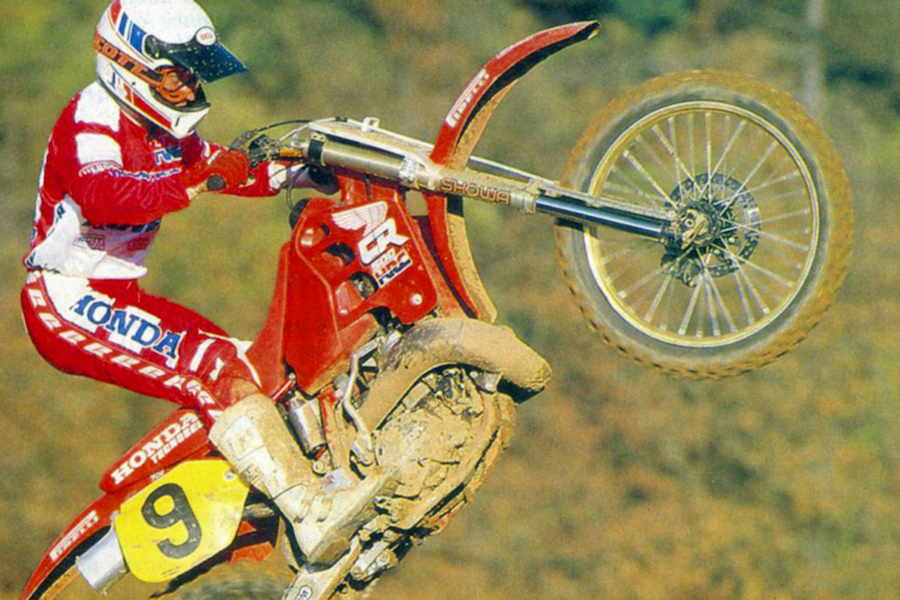
Words Ivar de Gier Photography Archives A. Herl